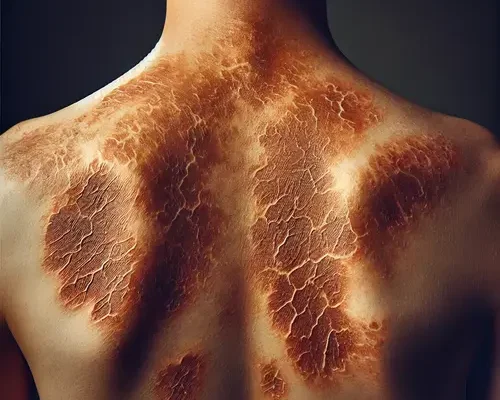Case Start: Imagine Isabel, a 27-year-old living in a warm, humid climate, notices patches of discolored skin on her back and shoulders. At first, she thinks it’s a tan gone wrong, but the spots seem to spread, and no amount of moisturizing helps. The patches are more noticeable when she tans, as the affected skin doesn’t darken. Isabel starts feeling self-conscious and wonders what’s causing this. Her doctor soon diagnoses her with pityriasis versicolor (also known as tinea versicolor), a common fungal skin condition.
Symptom Breakdown:
Pityriasis versicolor, also referred to as fungal skin infection, occurs when a type of yeast that normally lives on the skin grows out of control. This overgrowth leads to small, discolored patches of skin that can appear lighter or darker than the surrounding area.
Key Symptoms:
- Patches of skin discoloration (white, pink, tan, or brown)
- Slight scaling or flaking on the affected areas
- Mild itching, especially in warm weather
- Most commonly found on the back, chest, neck, and upper arms
People often first notice the condition after spending time in the sun, as the spots become more apparent when the surrounding skin tans while the affected areas remain pale.
Diagnostic Path: What Causes Tinea Versicolor?
Several factors can trigger tinea versicolor. While the yeast is naturally present on the skin, certain conditions make it more likely to overgrow:
- Hot and Humid Climates:
The yeast thrives in moist environments, which is why people living in tropical or humid regions are more prone to developing this condition. - Oily Skin:
People with naturally oily skin are at higher risk since the yeast feeds on the skin’s oils, leading to faster growth. - Weakened Immune System:
Those with a weakened immune system, whether due to illness or medications, may experience an overgrowth of the yeast, resulting in tinea versicolor. - Hormonal Changes:
Adolescents and young adults are particularly susceptible, as hormonal fluctuations can affect the balance of yeast on the skin. - Excessive Sweating:
Individuals who sweat heavily, whether due to exercise or hot weather, are more likely to develop the condition. Sweat creates the ideal environment for yeast growth, making it hard for the skin to regulate.
Deep Dive: How Does Pityriasis Versicolor Affect the Skin?
This condition is often misunderstood as skin discoloration from sun exposure or other causes, but the underlying issue is the yeast’s effect on skin pigmentation. The yeast, Malassezia, interferes with the normal pigmentation process by affecting melanin production. This is why the patches remain lighter or darker compared to the surrounding skin.
Although it’s not contagious or harmful, tinea versicolor can be persistent. It may clear up in cooler, drier months but often returns when conditions (like hot weather) favor yeast growth.
Treatment Comparison: How to Get Rid of Tinea Versicolor
The good news is that pityriasis versicolor is treatable, although it may take time for skin color to return to normal. Here are some of the most effective treatment options:
- Topical Antifungals:
- Antifungal creams, lotions, or shampoos containing ingredients like selenium sulfide, ketoconazole, or clotrimazole can be applied directly to the affected areas. These treatments work by reducing yeast growth and preventing it from spreading further.
- Oral Antifungals:
- For more severe cases or when topical treatments are ineffective, doctors may prescribe oral antifungal medications, such as fluconazole or itraconazole. These work systemically to eliminate the overgrowth of yeast from within.
- Self-Care and Prevention:
- Regularly using antifungal body washes or shampoos can help prevent recurrence, especially in hot and humid environments.
- Avoiding excessive sun exposure, wearing loose clothing, and keeping skin dry can also help manage the condition.
Although treatment can stop the yeast overgrowth quickly, it may take weeks or months for skin discoloration to resolve fully.
Outcome Story: Long-Term Management of Pityriasis Versicolor
Let’s consider another case: Nathan, a 34-year-old athlete, develops patches of lighter skin across his chest and neck after spending the summer training outdoors. After seeing a dermatologist, Nathan is diagnosed with tinea versicolor. His doctor recommends a daily antifungal shampoo and tells him to apply it after each workout. Nathan also starts wearing breathable, moisture-wicking fabrics to reduce sweat buildup. Within a few weeks, the patches stop spreading, and while it takes a few months for his skin tone to even out, Nathan is able to control the condition and prevent future flare-ups.
Managing Pityriasis Versicolor for Clearer Skin
While pityriasis versicolor isn’t dangerous, it can be a persistent and frustrating condition, especially for those who live in warm, humid climates. Understanding the causes and effective treatments for this common fungal infection is the key to keeping it under control. If you notice patches of discolored skin that don’t go away, consider seeing a dermatologist for proper diagnosis and treatment.
By maintaining good skin care habits and using antifungal treatments, you can manage tinea versicolor and prevent it from recurring, helping your skin return to its natural, healthy appearance.









